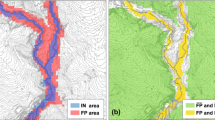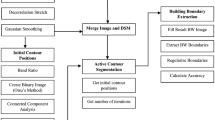Abstract
The objective of the paper is to present a new risk-analysis approach for the assessment of optimal flood protection levels in urban flood risk management, which is based on an active contour method. Although the active contour method is a very popular research topic, there has been no attempt made on deriving a model for simulating flooding and inundating to date, as far as we are aware. We have developed a flooding prototype system, which consists of two main parts: a digital terrain model and a flood simulation model. The digital terrain model is constructed using real world measurement data of GIS, in terms of digital elevation data and satellite image data. A pyramidal data arrangement structure is used for dealing with the requirements of terrain details with different resolutions. A new flooding model has been developed, which is useful for urban flood simulation. It consists of a flooding image spatial segmentation based on an active contour model, a water level calculation process, a standard gradient descent method for energy minimisation. When testing the 3D flood simulation system, the simulation results are very close to the real flood situation, and this method has faster speed and greater accuracy of simulating the inundation area in comparison to the conventional 2D flood simulation models.
Similar content being viewed by others
References
Haile, A.T., Rientjes, T.H.M.: Effects of LIDAR DEM resolution in flood modelling: a model sensitivity study for the city of Tegucigalpa, Honduras. In: ISPRS WG III/3, III/4, V/3 Workshop “Laser scanning 2005”, Enschede, The Netherlands, September 12–14 (2005)
Gianinetto, M., Villa, P., Lechi, G.: Postflood damage evaluation using Landsat TM and ETM+ data integrated with DEM. IEEE Trans. Geosci. Remote Sens. 44(1) (2006)
Sequeira, V., Wolfart, E., Bovisio, E., Biotti, E., Gonçalves, J.G.M.: Hybrid 3D reconstruction and image-based rendering techniques for reality modelling. SPIE 4309, 126–136 (2001)
Debevec, P.: Image-based techniques for digitizing environments and artifacts. In: Proc. 4th Int’l Conf. 3-D Digital Imaging and Modelling (3DIM 03), pp. 234–242. IEEE Press, New York (2003)
Hakim, S., El, F.: Semi-automatic 3D reconstruction of occluded and unmarked surfaces from widely separated views. In: Proc. ISPRS Commission V Symp., pp. 143–148, Ziti Publishing (2002)
Bender, J., Finkenzeller, D., Oel, P.: HW3D: A tool for interactive real-time 3D visualization in GIS supported flood modelling. In: Proceedings of the 17th International Conference on Computer Animation & Social Agents, Geneva (Switzerland), 7–9 July (2004)
Wang, C., Wan, T.R., Palmer, I.J.: A real-time dynamic simulation scheme for large-scale flood hazard using 3D real world data. In: 11th International Conference on Information Visualisation, Zürich, Switzerland, pp. 607–612 (2007)
Chan, T.F., Vese, L.A.: Active contours without edges. IEEE Trans. Image Process. 10(2), 266–277 (2001)
Ahuja, N., Nash, C.: Octree representation of moving objects. Proc. Comput. Vis. Graph. Image Process. 26, 207–216 (1984)
Chen, H.H., Huang, T.S.: A survey of construction and manipulation of octrees. Proc. Comput. Vis. Graph. Image Process. 43, 409–431 (1988)
Ulrich, T.: Continuous LOD terrain meshing using adaptive quadtrees. GameTechnology (2000). (http://www.gamasutra.com/features/20000228/ulrich_pfv.htm)
Duchaineau, M.A., Wolinsky, M., Sigeti, D.E., Miller, M.C., Aldrich, C., Mineev-Weinstein, M.B.: ROAMing terrain: real-time optimally adapting meshes. In: Proceedings of the 8th Conference on Visualization ’97. Phoenix, Arizona, United States, pp. 81–88. IEEE Comput. Soc., Los Alamitos (1997)
Lindstrom, P., Koller, D., Ribarsky, W., Hodges, L.F., Faust, N., Turner, G.A.: Real-time, continuous level of detail rendering of height fields. In: Proceedings of SIGGRAPH 1996 (August 1996)
Liu, Y.L., Miao, Z.H.: Key technique of floods prevention information system based on GIS. In: Proceedings of Geoscience and Remote Sensing Symposium, 2005, IGARSS’05, vol. 6, pp. 4395–4398. IEEE Press, New York (2005)
Caselles, V., Catte, F., Coll, T., Dibos, F.: A geometric model for active contours in image processing. Numer. Math. 66, 1–31 (1993)
Kass, M., Witkin, A., Terzopoulos, D.: Snakes: active contour models. Int. J. Comput. Vis. 1, 321–331 (1987)
Douglas, J.F., Gasiorek, J.M., Swaffield, J.A.: Fluid Mechanics. Pearson Education, Uppwe Saddle River (2001). ISBN0582414768
http://www.thamesweb.com/topic.php?topic_name=Flood%20Defence
Potsdam Institute for Climate Impact Research. http://www.pik-potsdam.de/
House of Commons: Climate change, water security and flooding. In: Environment, Food and Rural Affairs Committee. Sixteenth Report of Session (2004)
Author information
Authors and Affiliations
Corresponding author
Rights and permissions
About this article
Cite this article
Wang, C., Wan, T.R. & Palmer, I.J. Urban flood risk analysis for determining optimal flood protection levels based on digital terrain model and flood spreading model. Vis Comput 26, 1369–1381 (2010). https://doi.org/10.1007/s00371-009-0414-5
Published:
Issue Date:
DOI: https://doi.org/10.1007/s00371-009-0414-5




